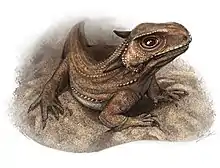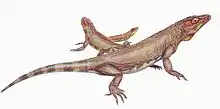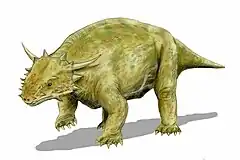Procolophonomorpha
Procolophonomorpha is an order or clade containing most parareptiles. Many papers have applied various definitions to the name, though most of these definitions have since been considered synonymous with modern parareptile clades such as Ankyramorpha and Procolophonia. The current definition of Procolophonomorpha, as defined by Modesto, Scott, & Reisz (2009), is that of as a stem-based group containing Procolophon and all taxa more closely related to it than to Milleretta. It constitutes a diverse assemblage that includes a number of lizard-like forms, as well as more diverse types such as the pareiasaurs. Lee 1995, 1996, 1997 argues that turtles evolved from pareiasaurs, but this view is no longer considered likely. Rieppel and deBraga 1996 and deBraga and Rieppel, 1997 argue that turtles evolved from sauropterygians, and there is both molecular and fossil (Pappochelys) evidence for the origin of turtles among diapsid reptiles.
| Procolophonomorphs Temporal range: Gzhelian - Late Triassic, | |
|---|---|
 | |
| Kapes bentoni (Procolophonidae) | |
 | |
| Scutosaurus (Pareiasauria) | |
| Scientific classification | |
| Domain: | Eukaryota |
| Kingdom: | Animalia |
| Phylum: | Chordata |
| Class: | Reptilia |
| Clade: | †Parareptilia |
| Order: | †Procolophonomorpha Romer, 1964 |
| Subgroups | |
Classification
The following cladogram is simplified after the phylogenetic analysis of MacDougall and Reisz (2014) and shows the placement of Procolophonomorpha within Parareptilia and its interrelationships. Relationships within bolded terminal clades are not shown.[1]
| Parareptilia |
| ||||||||||||||||||||||||||||||||||||||||||||||||||||||||||||||||||||||||||||||||||||||||||||||||
References
- Carroll, R. L., 1988: Appendix; Vertebrate Classification. in Carroll, R. L. 1988: Vertebrate Paleontology and Evolution, W. H. Freeman and Company, New York
- deBraga M. and O. Rieppel. 1997. "Reptile phylogeny and the interrelationships of turtles". Zoological Journal of the Linnean Society 120: 281–354.
- deBraga, M. and Reisz, R. R., 1996: "The Early Permian reptile Acleistorhinus pteroticus and its phylogenetic position". Journal of Vertebrate Paleontology: Vol. 16, #3, pp. 384–395
- Laurin, M., and Gauthier, J. A., 1996 Phylogeny and Classification of Amniotes, at the Tree of Life Web Project
- Lee, M. S. Y. 1995. "Historical burden in systematics and the interrelationships of 'Parareptiles'". Biological Reviews of the Cambridge Philosophical Society 70: 459–547.
- Lee M. S. Y. 1996. "Correlated progression and the origin of turtles". Nature 379: 812–815.
- Lee, M. S. Y., 1997: "Pareiasaur phylogeny and the origin of turtles". Zoological Journal of the Linnean Society: Vol. 120, pp. 197–280
- Rieppel O. and M. deBraga. 1996. "Turtles as diapsid reptiles". Nature 384: 453–455.
- Mark J. MacDougall and Robert R. Reisz (2014). "The first record of a nyctiphruretid parareptile from the Early Permian of North America, with a discussion of parareptilian temporal fenestration". Zoological Journal of the Linnean Society. 172 (3): 616–630. doi:10.1111/zoj.12180.






